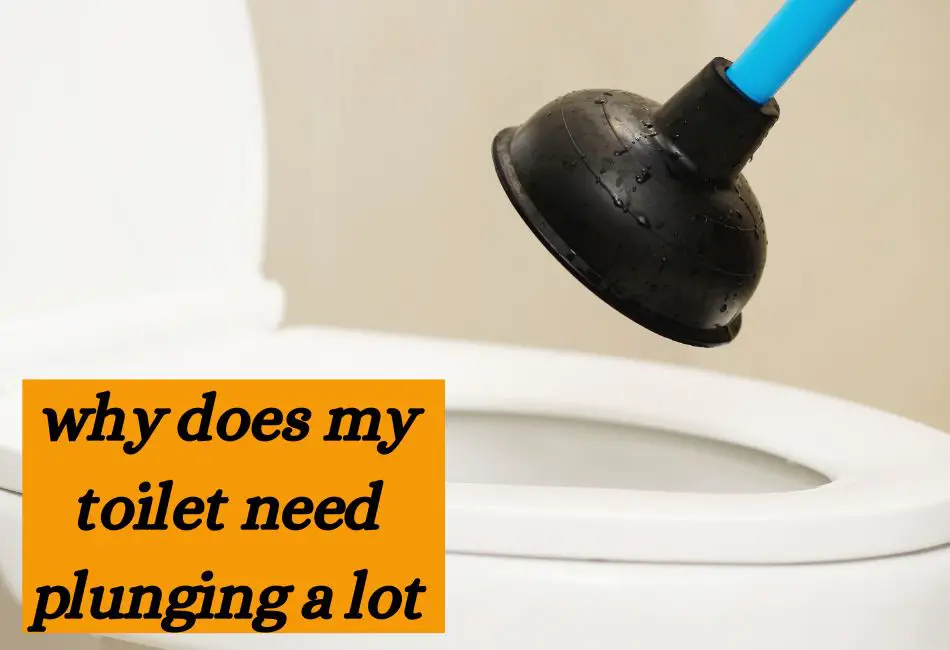We’ve all been there before. The toilet gurgles, the water level rises, and we reach for the faithful plunger again.
It’s a common household issue, but have you ever wondered why your toilet requires frequent plunging?
It’s not just an inconvenience but could also be a sign of a more substantial underlying problem. Understanding the reasons behind this seemingly minor issue is crucial.
Not only can it save you from future plumbing disasters, but it also helps maintain the hygiene and functionality of your household. Let’s explore why your porcelain throne might be challenging you.
1. Inadequate Water Flow
Believe it or not, I’ve also had my share of battles with a weak flush. One of the most common culprits? Inadequate water flow.
You see, for your toilet to flush correctly, there needs to be enough water flowing from the tank into the bowl. If there isn’t sufficient water, the flushing action lacks the power to clear the bowl effectively.
Causes of Insufficient Water in the Tank
You may be wondering, “What can cause inadequate water flow?” Well, here are a few potential causes:
- Low water pressure: This was a problem in my old apartment. The water pressure in the entire building was low, affecting the toilet tank’s filling.
- Faulty flush valve: I encountered another issue when I noticed the water in my toilet tank wasn’t reaching the fill line.
The flush valve wasn’t completely sealing the opening between the tank and the bowl, causing water to leak instead of filling the tank.
Solutions and Maintenance Tips
To tackle inadequate water flow, you can try the following:
Check your water valve: Ensure it’s fully open to allow maximum water flow.
- Adjust the float: This will control the fill valve and allow more water into the tank.
- Replace the flush valve: If it’s worn out or faulty, a new flush valve can make a world of difference!
2. Clogs in the Drain Pipes
Ah, clogs, the arch-nemesis of smooth flushing! The second reason your toilet may require frequent plunging is clogged drain pipes.
How Clogs Develop Over Time
Over time, various items and substances can build up in your toilet pipes, creating blockages that hinder the free flow of water.
I’ll never forget when I realized my toddler had discovered the joy of flushing his toy cars!
Common Culprits
Here are a few common culprits that tend to cause clogs:
- Toilet paper: Even too much toilet paper can clog your pipes!
- Foreign objects: As mentioned earlier, kids love throwing things into the toilet and flushing them away. It’s not just toys – anything from hair to wipes can cause a blockage.
- Mineral deposits: If your area has hard water, over time, the minerals in the water can deposit, creating a clog.
Preventing and Addressing Drain Pipe Clogs
To prevent and addressing drain pipe clogs, try these tips:
- Be mindful of what you flush: Only human waste and toilet paper should go into the toilet.
- Use a toilet auger: This tool is great for breaking up clogs deep in the pipes.
Regular maintenance: Have a professional plumber inspect your toilet and pipes periodically. Prevention is better than cure, after all!
3. The Fickle Flapper Valve
The flapper valve, an unsung hero of the toilet, plays a pivotal role in the flushing process. Think of it like a gatekeeper.
It opens to let water rush from the tank into the bowl when you flush, then seals the passage back up again so the tank can refill for the next use.
It’s Not Always Smooth Sailing
However, like most things, the flapper valve isn’t immune to problems. Wear and tear from constant usage can make it less efficient over time.
Sometimes, it may become misaligned and fail to seal the passage properly or decay from prolonged contact with water.
If you’ve ever had a toilet that seems to run endlessly after a flush, you can likely blame a faulty flapper valve. I recall when my bathroom sounded like a trickling creek due to this issue!
DIY Inspection and Repair
Luckily, inspecting and repairing a flapper valve isn’t rocket science. You can start by removing the tank lid and checking the flapper.
You can attempt to readjust or replace it if it seems worn out or misaligned. There are plenty of DIY videos out there to guide you. I once replaced my flapper valve, and let me tell you, it felt quite rewarding!
4. Septic System: A Silent Saboteur
Your toilet doesn’t operate in isolation; it’s part of a larger waste management system – the septic system. This system can significantly influence how your toilet functions.
Recognizing the Warning Signs
Signs of septic system issues can be quite noticeable yet often overlooked. If you’re experiencing backups, slow drains, or a nasty smell around your home, your septic system might throw a tantrum.
I remember waking up one morning to a slow-draining toilet and dismissing it as a one-time issue, only to have a full-blown septic backup a few days later.
Septic System Maintenance Tips
Maintaining a healthy septic system is key to preventing toilet issues. Regular pumping of your septic tank, ideally every 2-3 years, is a good practice.
Using biodegradable toilet paper and avoiding flushing foreign objects can save your septic system from stress.
Biologically based septic additives can also help maintain a good balance of beneficial bacteria in your system. Trust me, your toilet (and your nose) will thank you for taking care of your septic system!
5. Aging Plumbing Infrastructure
Older homes often come with aging plumbing infrastructure. I experienced this firsthand when I bought my charming, somewhat aged, mid-century home.
The pipes and plumbing components were just as old as the house, and let me tell you, it started showing in the form of toilet problems.
The Trouble with Old Pipes
One of the common problems with aging pipes is corrosion. As the metal corrodes over time, it can cause leaks, which can lead to water pressure issues.
I remember this one time I had to deal with an unexpected leak in the bathroom, and needless to say, it was not a pleasant experience.
Upgrading Your Plumbing
If you’re facing constant plumbing issues, it might be time to consider upgrading or replacing the outdated elements.
When I finally decided to replace the old pipes in my home, I noticed a significant improvement in water pressure and fewer issues with the toilet. It was an investment worth making!
6. Hard Water Deposits
Living in a region with hard water has its own set of challenges. The high mineral content in hard water can build up deposits in your toilet pipes, which can affect flushing.
Recognizing Hard Water Deposits
The first time I noticed a whitish, crusty deposit around my faucets and showerheads, I had no idea it resulted from hard water.
But then I started having issues with the toilet flush. I soon realized these deposits also clogged my toilet pipes, affecting their functionality.
Tackling the Hard Water Issue
I installed a water-softening system in my home to counter hard water deposits. This has helped reduce the buildup of mineral deposits in the pipes over time.
Regularly cleaning the toilet bowl with vinegar also helps prevent hard water stains. Trust me, preventive maintenance can save you a lot of trouble in the long run!
Conclusion
To wrap up, let’s revisit the six main reasons we’ve covered that might lead to the necessity of frequent toilet plunging.
Firstly, we discussed the issues caused by using too much toilet paper and followed up with the problems that arise from flushing non-flushable items.
Thirdly, we touched upon plumbing design issues and then moved on to the problems associated with aging pipes.
Fifthly, we discussed upgrading your plumbing and, finally, the challenges of hard water deposits.
I cannot stress enough the importance of regular maintenance and prompt issue resolution. I speak from experience.
Neglecting small issues in the beginning can lead to major, more costly problems. I’ve learned that preventing a problem is much easier than fixing it.
Regularly checking your toilet pipes and promptly addressing any minor issues can save you from the headache of major repairs.
If you’re facing persistent toilet problems, don’t hesitate to seek professional help. I used to be someone who would try to fix everything myself, but I’ve come to understand that it’s okay to ask for help when things are beyond my control or expertise.
I’ve found that skilled professionals can identify and fix problems faster and more efficiently than I could.
They can often prevent future issues by spotting and correcting underlying problems. It’s worth the investment to ensure the proper functioning of one of the most essential amenities in your home.

